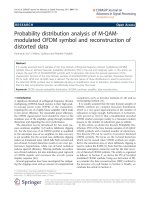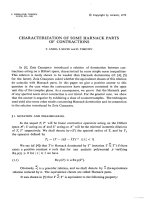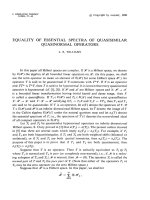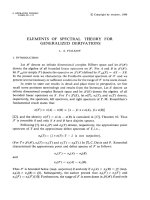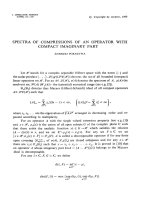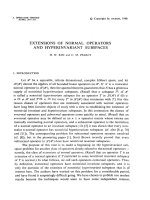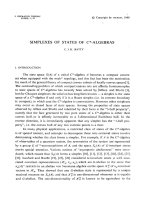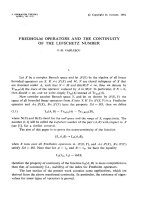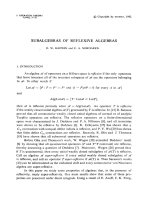Báo cáo toán học: "Probability of germination after heat treatment of native Spanish pines" ppsx
Bạn đang xem bản rút gọn của tài liệu. Xem và tải ngay bản đầy đủ của tài liệu tại đây (1.1 MB, 10 trang )
Original
article
Probability
of
germination
after
heat
treatment
of
native
Spanish
pines
Adrián
Escudero*
María
Victoria
Sanz
José
Manuel
Pita
Félix
Pérez-García
Dept.
Biología
Vegetal,
Escuela
de
Ingeniería
Técnica
Agrícola,
Universidad
Politécnica
de
Madrid,
Madrid,
28040,
Spain
(Received
6
April
1998;
accepted
1 February
1999)
Abstract -
Spanish
pine
forests
exhibit
a
high
degree
of
resilience
to
frequent
wildfires.
For
this
reason,
they
have
been
considered
as
active
pyrophytes.
However,
the
primary
evidence
of
the
fire
response
of
some
of
the
seven
Spanish
pines
suggests
that
they
are
not
real
pyrophytes
because
germination
enhancement
has
not
been
detected.
In
order
to
investigate
the
germination
response
of
the
Spanish
pine
seeds
after
heating,
seeds
were
submitted
to
different
treatments
at
varying
temperatures
(50-130 °C)
and
exposure
times
(1-15
min)
to
simulate
responses
to
different
fire
regimes
and
situations.
The
probability
of
germination
after
heating
was
mod-
elled
by
means
of
multiple
logistic
regressions
using
temperature,
time
and
their
interaction
as
predictors.
Very
predictive
models
were
found
for
all
the
pines,
except
for
Pinus
pinea.
Seeds
germinate
readily
without
treatment,
losing
their
viability
within
a
short
time
and
showing
a
slight
protection
from
fire.
The
results
suggest
that,
despite
the
fact that
these
pines
all
occur
in
fire-prone
envi-
ronments,
their
germination
behaviour
has
clearly
not
evolved
in
relation
to
fire
alone.
Furthermore,
seed
behaviour
is
not
related
to
the
general
syndromes
described
as
typical
of
fire-evolved
plants.
Whereas
most
of
the
Mediterranean
seeders
base
their
efficient
recruitment
after
wildfires
on
the
presence
of
hard-coated
seeds,
most
of
the
Mediterranean
pines
have
attempted
other
strategies
with
some
variants
related
to
prolific
seed
production.
Only
P.
pinea
regeneration
after
wildfires
depends
on
the
existence
of
fire-
resistant
and
hard-coated
seeds.
(©
Inra/Elsevier,
Paris.)
heat
treatments
/
Mediterranean
pine
forests
/
multiple
logistic
regression
/
seed
germination
/
wildfires
Résumé -
Probabilité
de
germination
des
graines
de
pins d’origine
espagnole
après
traitement
par
chauffage.
Les
pins
espa-
gnols
montrent
un
haut
degré
de
résilience
aux
feux
fréquents.
Pour
cette
raison,
ils
ont
été
considérés
comme
des
pyrophytes
actifs.
Cependant,
l’évidence
première
de
la
réponse
au
feu
de
certaines
des
sept
espèces
de
pins
espagnols
suggère
qu’elles
ne
sont
pas
de
réelles
pyrophytes
car
aucune
augmentation
de
germination
n’a
été
observée.
Afin
de
connaître
la
réponse
à
la
germination
des
graines
après
chauffage,
des
graines
furent
exposées
à
différents
traitements
de
gradients
de
température
(50 °C
à
130 °C)
et
de
durée
(1
min
à
15
min)
afin
de
simuler
la
réponse
à
différents
régimes
de
situation
de
feu.
La
probabilité
de
germination
après
chauffage
a
été
modélisée
au
moyen
de
régressions
multiples
logistiques
utilisant
la
température,
la
durée
d’exposition
et
leur
interaction
comme
variables
prédictives.
De
très
bons
modèles
prédictifs
ont
été
établis
pour
tous
les
pins,
excepté
pour
Pinus
pinea.
Les
graines
ger-
ment
déjà
sans
traitement,
perdent
rapidement
leur
capacité
germinative
et
montrent
une
faible
protection
au
feu.
Les
résultats
suggè-
rent
que,
en
dépit
du
fait
que
tous
ces
pins
soient
localisés
dans
un
environnement
propice
à
l’incendie,
il
est
clair
que
leur
comporte-
ment
germinatif
n’a
pas
uniquement
évolué
en
relation
avec
les
feux.
En
outre,
le
comportement
des
graines
n’est
pas
relié
au
syndrome
général
décrit
comme
typique
de
l’évolution
des
plantes
sous
l’influence
du
feu.
Alors
que
la
plupart
des
semenciers
médi-
terranéens
basent
leur
efficiente
régénération
après
passage
du
feu
sur
l’existence
de
graines
à
téguments
épais,
la
plupart
des
pins
méditerranéens
ont
établi
d’autres
stratégies
avec
des
variantes
reliées
à
une
production
prolifique
de
graines.
Après
incendie,
seule
la
régénération
de
P.
pinea
dépend
de
l’existence
de
graines
résistantes
au
feu
et
avec
des
téguments
épais.
(©
Inra/Elsevier,
Paris.)
chauffage
/
forêts
de
pins
méditerranéens
/
régression
multiple
logistique
/
germination
des
graines
/
feu
sauvage
*
Correspondence
and
reprints
E-mail:
1.
Introduction
As
in
other
Mediterranean
ecosystems,
pine
forests
seem
to
exhibit
a
high
degree
of
resilience
to
frequent
wildfires
[38, 40, 61].
For
that
reason,
Mediterranean
pines
have been
traditionally
considered
as
’active
pyro-
phytes’
[1, 2,
10,
28,
30,
31, 54,
57,
59,
65]
and
even
their
forests
as
’fire
type’
or
’fire
climax’.
The
reasons
for
this
biological
interpretation
must
be
related
to
the
fact that
Mediterranean
pine
forests
are
particularly
prone
to
periodic
fires
[17,
57],
thousands
of
hectares
being
burnt
every
year
around
the
Mediterranean
basin.
Pine
forests
are
usually
able
to
recover
their
former
structure
after
wildfires
[39].
Furthermore,
the
existence
of
some
remarkable
adaptive
traits
developed
to
couple
with
fire-induced
disturbances
such
as
seed
retention
in
the
canopy
(serotiny)
or
xerochasic
opening
of
the
cones
of
some
of
them
[14,
54],
seem
to
indicate
a
clear
evolu-
tionary
relationship
between
pines
and
fire.
However,
evidence
of
germination
enhancement
by
fire
in
some
of
these
pines
is
almost
absent
[57,
60]
and
the
more
realis-
tic
term
’adapted
to
fire’
has
been
applied
to
them.
In
this
sense,
Lamont
et
al.
[29]
point
out
that
of
the
95
species
in
the
genus
Pinus
only
six
species
are
consid-
ered
obligatory
pyriscent,
although
many
of
them
are
highly
competitive
in
the
post-fire
environment.
On
the
other
hand,
Mediterranean
pines
have
long
been
consid-
ered
photophilous
generalist
plants
with
a
high
capacity
for
spatial
and
biological
selection
to
colonization
after
any
type
of
disturbance
[3, 4].
Recently,
several
authors
have
noted
that
some
of
these
pines
are
not
genuine
pyrophytes
[15,
36, 46]
because
their
germination
is
not
stimulated
by
heat
treat-
ments
as
occurs
in
many
other
Mediterranean
shrubs
[13,
18,
23, 52,
56,
62, 66,
69].
Furthermore,
some
difficul-
ties
in
the
re-establishment
of
some
of
these
pines
after
intense
fires
have
also
been
reported,
as
in
the
case
of
P.
pinaster
and
P.
halepensis
(Escudero,
per.
obs.),
P.
pinaster
in
Portugal
[10]
and
P.
nigra
[15,
63].
Our
main
goal
is
to
model
the
germination
behaviour
of
the
Spanish
pines
after
heat
treatments
in
order
to
establish
the
evolutionary
relationships
between
pines
and
wildfires
at
this
life
stage.
For
that,
seeds
were
sub-
jected
to
different
’fire
intensity’
treatments
at
varying
temperatures
and
exposure
times
to
simulate
responses
to
different
fire
regimes
or
microtopographic
fire-driven
heterogeneity
[46].
The
probability
of
germination
after
heating
was
modelled
by
means
of
logistic
curves
using
temperature,
exposure
time
and
their
interaction
as
pre-
dictors.
2.
Materials
and
methods
2.1.
Short
description
of
the
pines
Six
of
the
11
pine
species
naturally
growing
in
Europe
are
present
in
the
Iberian
Peninsula.
Most
of
these
pines
have
been
planted
for
timber
or
even
for
edible
seeds
for
centuries;
thus,
in
many
cases
the
original
boundaries
of
their
distributions
are
not
easily
definitively
established.
P.
halepensis
Miller,
P.
pinea
L.
and
P.
pinaster
Aiton
are
low-altitude
pines
widely
distributed
in
the
Mediterranean
Basin.
P.
pinea
is
found
mainly
on
sandy
soils,
whereas
P.
pinaster
grows
on
acid
soils
and
P.
halepensis
mainly
on
calcareous
soils.
On
the
other
hand,
P.
uncinata
Ramond
ex
DC.
is
a
narrowly
distrib-
uted
sub-Alpine
pine,
confined
to
the
Pyrenees
and
some
isolated
populations
in
the
Sistema
Ibérico
range.
P.
nigra
Arn.
is
a
very
variable
Mediterranean
pine
which
grows
in
the
supra-Mediterranean
and
mainly
on
the
oro-
Mediterranean
belts
of
the
highest
ranges
of
the
eastern
half
of
the
Iberian
Peninsula
(biogeographical
terms
fol-
lowing
Rivas-Martínez
[48]).
The
Spanish
populations
have
been
ascribed
to
P.
nigra
Arn.
subsp.
salzmannii
(Dunal)
Franco.
P.
sylvestris
L.,
a
typical
and
wide-
spread
European
pine,
is
basically
a
Spanish
oro-
Mediterranean
and
subalpine
pine
which
reaches
here
its
southern
and
western
limits.
Finally,
P.
canariensis
Sweet
ex
Spreng,
which
is
an
endemic
pine
of
the
Canary
Islands,
was
also
included
in
the
study.
2.2.
Experimental
design
Seeds
were
obtained
from
the
Institute
for
Nature
Conservation,
Ministry
of
Environment
(1995-1996
har-
vest).
Seed
provenances
used
in
the
present
study
were
P.
sylvestris
from
Soria
province,
P.
nigra
from
Cuenca
province,
P.
uncinata
from
Huesca
province,
P.
pinea
from
Madrid
province,
P.
pinaster
from
Albacete
province,
P.
halepensis
from
Jaén
province
and
P.
canariensis
from
Tenerife
Island.
Seeds
were
stored
at
6
°C
in
darkness
in
open
containers.
Seeds
were
submit-
ted
to
different
combinations
of
high
temperatures
and
times
in
order
to
cover
a
wide
range
of
conditions
encountered
by
seeds
during
fires.
Twenty
heat
treat-
ments
were
carried
out.
Heat
treatments
were
as
follows:
50 °C
(1,
3,
7,
10
and
15
min),
70 °C
(1,
3,
7,
10
and
15
min),
100 °C
(1,
3,
7
and
10
min),
130 °C
(1
and
3
min)
and
150 °C
(1
and
3
min).
A
control
treatment
was
also
carried
out.
Parameters
of
the
control
were
included
in
the
models
as
20 °C
and
I
min
of
exposure
time.
Germination
tests
for
each
heat
treatment
were
per-
formed
with
100
seeds
in
four
Petri
dishes
(9
cm
in
diameter)
on
two
filter
papers
moistened
with
distilled
water.
The
dishes
were
placed
in
controlled
environmen-
tal
cabinets
at
an
alternating
temperatures
of
15
°C/25
°C
with
a
16
h
light/8
h
dark
photoperiod
(Osram
fluores-
cent
tubes
L20
W/105,
30-45
Em-2
s
-1).
The
criterion
of
germination
was
visible
radicle
protusion.
Germination
was
checked
daily
and
the
germinated
seeds
were
removed.
After
30
days
the
experiments
were
concluded.
2.3.
Data
analysis
As
in
most
of
the
cases
the
difference
in
final
percent-
age
was
very
slight
among
the
lowest
intensity
treat-
ments
(control,
50
°C/1
min,
70
°C/1
min
and
100 °C/1
min
treatments),
the
Kaplan-Meier
method
was
adopted
to
estimate
germination
functions
due
to
right
censored
data.
The
shape
difference
in
the
modelled
ger-
mination
curves
was
tested
by
the
non-parametric
log-
rank
test
[45].
When
necessary,
differences
in
the
final
percentage
of
germination
were
evaluated
by
means
of
the
G-test.
Logistic
regressions
[21,
27]
were
performed
to
deter-
mine
whether
either
of
the
two
variables
considered
were
predictors
of
the
germination
probability.
We
tested
models
with
the
two
variables
(temperature
and
time)
and
their
interaction,
and
also
tested
all
the
reduced
mod-
els.
Logistic
relationships
are
of
the
following
form:
where
p
is
the
probability
of
germination
and
Z
is
a
lin-
ear
combination
of
the
variables
included
in
the
model.
The
coefficients
of
Z
are
estimated
by
maximization
of
the
likelihood
function.
Our
hypothesis
tests
are
based
on
the
change
in
the
-2
log
likelihood
ratio
after
building
models
with
and
without
variables
[19,
21,
67].
The
goodness
of
fit
of
each
model
is
evaluated
by
means
of
the
classification
table
and
tested
by
the
model
chi-
square
improvement
test.
All
the
models
included
in
table
I
were
highly
significant
(P
<
0.0005).
The
rele-
vance
of
each
variable
in
the
models,
including
interac-
tions,
was
tested
by
means
of
the
likelihood
ratio
test
as
recommended
by
Hosmer
and
Lemeshow
[20]
and
its
partial
contribution
to
the
model
evaluated
by
the
R
sta-
tistic.
Three
criteria
were
weighted
in
order
to
select
the
final
models
for
each
pine:
the
maximum
percentage
of
overall
correctly
classified
seeds,
the
minimum
-2
log
likelihood
ratio
or
deviance
and
simplicity
[67].
3.
Results
Seeds
readily
germinated
without
heat
treatment
(con-
trol)
in
all
cases,
though
some
differences
were
detected
between
the
seven
pines
(G
=
63.02,
d.f.
6,
P
<
0.0001).
Germinability
ranged
between
100
%
in
the
case
of
P.
sylvestris
to
70
%
in
P.
uncinata,
the
rest
being
above
the
85
%
of
P.
pinea.
The
total
number
of
germinated
seeds
in
each
treatment
is
presented
in
Appendix
1.
The
shapes
of
the
germination
curves
were
compared
within
each
species
for the
less
intense
treatments
(con-
trol,
50
°C/1
min,
70
°C/1
min
and
100
°C/1
min).
Three
different
patterns
were
detected
(figure
1).
The
first
appeared
in
P.
pinaster
for
which
no
significant
differ-
ences
(log-rank
test)
were
detected
between
the
curves.
P.
halepensis,
P.
uncinata
and
P.
sylvestris
presented
a
second
type
of
response
which
was
based
on
the
fact
that
control
seeds
germinate
significantly
faster
than
seeds
submitted
to
any
heat
treatment.
Finally,
P.
pinea,
P.
nigra
and
P.
canariensis
presented
significant
differ-
ences
between
treatments
involving
not
only
control
seeds.
All
the
logistic
models
developed
were
highly
signifi-
cant
(P
<
0.0005)
for
each
pine
(table
I),
except
for
P.
pinea,
with
the
number
of
overall
correctly
classified
cases
varying
between
62.11
%
for
P.
halepensis
and
89.47
%
for
P.
sylvestris.
The
models
for
P.
pinea
were
not
significant
(P
=
0.93
for
the
best
one).
The
number
of
germinated
seeds
in
P.
pinea
was
similar
in
each
treat-
ment
(around
80
%),
being
only
significantly
different
in
the
most
severe
treatment
(150
°C/3
min)
(G
=
31.3,
d.f.
17,
P
=
0.019
-n.s. -
after
comparing
all
but
this last
treatment,
and
G
=
88.79,
d.f.
18,
P
<
0.0001
after
including
all
the
treatments).
Contour
graphs
of
the
prob-
ability
of
germination
for
the
other
six
pines
are
present-
ed
in figure
2.
The
bold
0.5
isoline
masks
the
line
in
the
temperature
x
time
space
where
the
probability
of
germi-
nation
is
50
%.
Above
this
line,
seeds
have
a
chance
to
germinate.
3.
Discussion
Spanish
pines
can
hardly
be
considered
as
genuine
pyrophytes,
since
a
significant
germination
enhancement
has
not
been
detected
after
heating
treatment
in
any
of
them.
Nevertheless,
the
concept
of
pyrophyte
is
under
revision
at
present,
even
for
some
Mediterranean
plants
such
as
Cistaceae
or
Leguminosae
species
described
as
classical
examples
of
pyrophytes,
because
their
germina-
tion
has
been
experimentally
proven
to
be
stimulated
by
heat.
Thus,
in
population
dynamic
terms,
these
Mediterranean
plants
are
now
considered
heliophilous
pioneers,
not
only
associated
with
fire,
but
also
with
col-
onizing
disturbed
areas
free
of
competitors
[32,
44,
53,
62].
In
this
context,
physical
dormancy
of
hard-coated
seeds
can
be
broken
by
fire
because
of
the
desiccation
of
the
seed
coat
[9]
but
not
exclusively
[5,
6].
Thus,
although
seed
germination
is
enhanced
by
heat
shock,
germination
can
also
be
triggered
by
any
perturbation
able
to
alter
the
seed
coat
[5,
6].
This
is
a
widely
spread
strategy
in
colonizers
adapted
to
very
fluctuating
envi-
ronments
such
as
those
of
Mediterranean
ecosystems
[50].
Pine
seeds
are
ready
to
germinate
(germinability
above
75
%
in
all
of
them
at
control)
in
contrast
to
seeds
from
typical
Mediterranean
shrubs,
which
present
a
deep
dormancy
based
on
coat
hardness
and
impermeability
[7,
13,
43,
55].
This
fact
suggests
that
pine
adaptation
to
perturbations
must
be
sustained
not
in
dormancy
charac-
teristics
or
structural
properties
that
prevent
immediate
germination
of
seeds
as
is
usual
in
Mediterranean
plants
[7, 8, 24, 56],
but
in
other
adaptive
responses.
As
suggested
by
the
differences
between
germination
models,
the
adaptive
traits
of
each
pine
species
may
be
specific.
Thus,
the
germination
behaviour
after
heat
treatment
of
two
of
the
Spanish
lowland
pines
(P.
halepensis,
P.
pinaster)
is
considerably
different
in
spite
of
the
fact that
their
establishment
is
based
on
a
very
similar
powerful
light-induced
regenerative
capacity
[51,
58],
a
yearly
production
of
prolific
seed
crops
and
the
safe-guarding
of
large
canopy
seed
banks
[29]
as
shown
by
Daskalakou
and
Thanos
[14]
in
P.
halepensis.
Germination
of
P.
pinaster
seems
to
be
mainly
con-
trolled
by
the
temperature
and
not
by
the
exposure
time,
reaching
values
of
probability
of
germination
below
0.5
only
when
temperature
surpasses
130 °C
(figure
2).
This
suggests
that
seed
cover
confers
a
resistance
over
a
wide
range
of
fire
intensities,
failing
only
when
high
tempera-
tures
are
reached
[36].
This
fact
agrees
with
the
lack
of
significant
differences
(log-rank
test)
between
the
germi-
nation
curves
after
the
less
severe
treatments
(figure
1)
Thus,
the
recruitment
of
this
pine
after
wildfires
seems
to
be
assured
by
the
combination
of
coat
resistance
and
cone
protection
and
not
by
the
existence
of
a
large
soil
seed
bank,
since
seed
longevity
is
barely
more
than
2
years
[36].
The
low
germinability
obtained
by
Reyes
and
Casal
[46]
might
be
a
consequence
of
a
fast
viability
loss
of
stored
seeds
[11,
12].
On
the
other
hand,
P.
halepensis
which
had
been
considered
primarily
as
a
genuine
pyrophyte
[28,
30,
59],
has
severe
problems
in
germinating
after
heat
treatment.
In
this
case,
seed
cover
confers
a
weaker
protection
and
the
exposure
time
becomes
relevant
(figure
2).
A
temperature
around
70 °C
could
determine
the
failure
of
the
seed
if
the
exposure
time
is
higher
than
10
min
[14,
36].
However,
postfire
recruitment
is
always
very
effective
even
after
very
intense
fires
[41,
35,
54].
Daskalakou
and
Thanos
[14]
suggested
that
the
efficient
postfire
regeneration
of
P.
halepensis
must
first
depend
upon
a
high
canopy
seed
bank
because
seeds
found
in
the
soil
are
killed
and
those
stored
in
cones
are
efficiently
protected.
Furthermore,
dissemination
from
seeds
of
edge
surviving
pines
is
very
limited
[2,
47].
Thus,
though
seed
mortality
can
become
very
important
in
some
wildfires
as
also
shown
for
our
models,
a
significant
number
of seeds
should
survive
[49].
After
that,
early
seedling
establishment
is
well
adapted
to
exploit
the
postfire
conditions
[64].
Another
problem
related
to
fire
disturbances
arises
after
compar-
ing
the
curves
of
germination:
control
seeds
are
faster
to
than
those
submitted
to
fire
intensity
treat-
ments
(figure
1).
Probably,
seeds
need
more
time
to
complete
their
imbibition
after
desiccation,
and
so
preda-
tion risk
by
granivorous
birds
could
be
increased
[49].
Seed
behaviour
of
the
third
Spanish
lowland
pine,
P.
pinea,
is
completely
different.
Germination
percentage
is
similar
after
almost
all
the
treatments,
a
significant
decay
being
detected
only
after
the
most
severe
one
(130
°C/3
min).
The
seed
size
is
one
of
the
highest
in
the
genus
[11].
Thus,
this
pinyon
pine
has
been
widely
planted
for
its
edible
seeds.
The
seed
weight
is
0.70
g
±
0.12
(n
=
200)
and
length
1.68
cm
±
0.14,
which
is
consider-
ably
higher
than
in
P.
canariensis:
weight,
0.12
g
±
0.03
and
length,
1.11
cm ±
0.13;
n
=
200).
These
results
seem
to
support
the
idea
exposed
by
Keeley
[22]
and
Reyes
and
Casal
[46]
that
larger
seeds
are
more
resistant
to
fire.
Then,
larger
seed
size
might
have
evolved
not
only
in
relation
to
dispersal
and
to
secure
survival
of
seedlings,
but
also
as a
response
to
wildfire.
This
idea
should
be
tested,
both
intra-
and
interspecifically.
Furthermore,
seeds
of
P.
pinea
are
wingless,
dispersing
only
under
the
canopy
of
parent
trees,
and
do
not
require
light
to
germi-
nate
[51].
Thus,
recruitment
after
fire
disturbance
should
be
a
rare
event
which
is
controlled
by
the
high
fire
resis-
tance
of
P.
pinea
seeds.
Montane
pines
also
show
problems
in
germinating
after
heat
treatment
(figure
2).
In
a
recent
paper,
we
commented
on
the
implications
at
the
community
level
of
this
behaviour
[15].
As
also
shown
by
Trabaud
and
Campant
[63]
recruitment
of
P.
nigra
after
catastrophic
wildfires
can
become
cumbersome.
Natural
forests
of
these
trees
(P.
nigra,
P.
sylvestris
and
P.
uncinata)
appear
on
the
oro-Mediterranean
and
sub-Alpine
belts
of
the
highest
mountain
of
the
eastern
half
of
the
Peninsula
or
on
rocky
sites
at
lower
altitudes,
such
as
spurs,
crests
and
step
slopes
[42].
In
such
situations,
tree
population
structure
results
in
a
patchy
distribution
of
trees,
sur-
rounded
by
a
general
matrix
of
creeping
scrubs,
caespi-
tose
grasses
and
bare rock
outcrops.
At
these
conditions,
wildfire
is
rarely
catastrophic
and
many
trees
can
easily
survive.
It
is
probably
for
this
reason
that
these
pines
base
their
dispersal
strategy
on
small seeds
more
easily
dispersed
by
wind
(P.
sylvestris:
weight,
0.01
g
±
0.005,
P.
uncinata: 0.01
g
±
0.01
and
P.
nigra:
0.02
g
±
0.01;
n
=
200).Thus,
pine
recruitment
in
the
postfire
environ-
ment
seems
to
be
secured
from
surviving
pines.
The
detected
problems
[15, 63]
and
the
high
incidence
of
fires
of
more
than
10
000
ha
[37,
68]
on
the
extensive
pine
forests
of
P.
sylvestris
and
P.
nigra
located
at
lower
altitudes
on
deeper
soils
(supra-Mediterranean
and
mon-
tane
belts)
is
most
likely
due
to
landscape
homogeniza-
tion
resulting
from
a
decrease
in
man-driven
distur-
bances
[3].
Thus,
after
wildfires
almost
all
seeds
die.
Dispersion
from
surviving
edge
pines
is
strongly
limited
because
the
size
of
the
burnt
areas
are
very
important
[47,
54].
Consequently,
resprouters
such
as
different
Quercus
species
which
are
usually
interspersed
in
the
subcanopy
can
rapidly
control
the
available
space
[12].
These
events
may
determine
notorious
landscape
changes
and
pines
can
become
locally
extinct.
Anyway,
these
pines
also
show
some
differences
in
their
germination
responses
after
high
temperature
treat-
ment.
P.
uncinata
germinability
is
highly
sensitive
to
heat
treatment,
whilst
indifferent
to
the
exposure
time.
A
temperature
above 70 °C
may
kill
the
seeds
even
after
a
short
period
(figure
2).
The
germination
behaviours
of
P.
sylvestris
and
P.
nigra
are
similar.
Seed
cover
confers
protection
on
the
embryo
in
a
very
narrow
range
of
tem-
peratures.
Even
low
temperatures
(50-70 °C)
can
cause
the
seeds
to
not
germinate
after
10-15
min.
Finally,
the
strategy
of
the
Canarian
pine
is
different.
Whereas
most
pines
regenerate
by
seeds
alone
because
adult
plants
are
killed
by
fire -
obligate
seeders,
P.
canariensis
is
capable
of
using
seeds
or
resprouts
to
recover
from
wildfires.
Mature
seeds
germinate
without
restriction
at
control
conditions
and
they
can
also
germi-
nate
at
lower
heat
temperatures,
the
exposure
time
not
being
relevant.
However,
at
higher
temperatures,
a
longer
time
exposure
induces
seed
death
(figure
2).
In
any
case,
only
field
experiments
can
lead
us
to
determine
the
role
of
seeds
in
the
regeneration
of
a
natural
Canarian
pine
forest.
4.
Conclusions
Whereas
most
of
the
Mediterranean
seeders
base
their
efficient
recruitment
after
wildfires
on
the
presence
of
hard-coated
seeds,
Mediterranean
pines
have
attempted
other
’strategies’
with
some
variants.
They
have chosen
another
solution
related
to
prolific
seed
production.
Seeds
germinate
readily
without
treatment,
losing
their
viability
in
short
periods
and
only
show
a
slight
protec-
tion
from
fire,
with
most
of
them
being
killed.
Thus,
lowland
pines,
such
as
P.
halepensis
and
P.
pinaster,
based
recruitment
in
the
postfire
environment
on
the
existence
of
a
large
canopy
seed
bank
and
a
certain
degree
of
serotiny
[14]
because
thermophilous
pine
forests
are
really
fire-prone
systems;
cones
of
up
20
years
of
age
contained
a
considerable
fraction
of
ger-
minable
seeds
in
P.
halepensis
[ 14].
As
shown
by
Fraver
[16]
the
temperature
transmission
into
cones
is
not
very
intense,
so
some
of
the
seeds
can
survive
and
be
released
to
the
soil
after
wildfire.
However,
P.
pinea
and
partially
also
P.
pinaster,
based
their
re-establishment
strategy
after
fire
on
the
presence
of
a
very
resistant
hard
coat
which
confers
protection
in
a
wide
range
of
tempera-
tures.
On
the
other
hand,
montane
pines
(P.
uncinata,
P.
nigra
and
P. sylvestris)
based
their
re-establishment
on
the
landscape
heterogeneity
and
a
more
efficient
disper-
sal
strategy,
sustaining
their
stand
regeneration
by
sur-
viving
trees.
Finally,
the
coincidence
of
prolific
crops
and
resprouting
in
P.
canariensis
might
have
evolved
as
a
response
to
low
mean
fire
intervals
and
the
necessity
to
exploit
new
bare
territories,
both
of
which
are
related
to
the
intense
volcanic
activity
of
the
Canary
Islands.
In
spite
of
the
fact
that
all
pines
occur
in
fire-prone
environments,
it
is
clear
that
their
germination
syn-
dromes
have
not
evolved
in
relation
to
wildfire
alone.
Furthermore,
seed
behaviour
is
not
related
to
the
general
syndromes
described
by
Keeley
[23]
as
being
typical
of
fire-evolved
plants.
This
author
points
out
that
species
that
germinate
readily
without
treatments
are
usually
resprouters,
which
is
not
the
case
here ,
except
for
P.
canariensis.
Acknowledgements
We
would
like
thank
to
Dr
Rubio
of
E.T.S.I.
Montes
(U.P.M.),
Dr
G.
Aussenac
(Inra-Nancy)
and
anonymous
reviewers
for
their
valu-
able
comments,
and
Jesús
Andrés
for
his
linguistic
assis-
tance.
This
research
was
financed
by
the
CAM
project
no.
06M/003/96
and
the
project
PB96-0004
of
the
Spanish
Ministry
of
Education.
References
[1]
Abbas
H.,
Barbero
H.,
Loisel
R.,
Réflexions
sur
le
dynamisme
actuel
de
la
régéneration
naturelle
du
pin
d’Alep
(Pinus
halepensis
Mil.)
dans
les
pinèdes
incendiées
en
Provence
calcaire
(de
1973
à
1979),
Ecol.
Medit.
10
(1984)
85-95.
[2]
Acherar
M.,
Lepart
J.,
Debussche
M.,
La
colonitation
des
friches
par
le
pin
d’Alep
(Pinus
halepensis
Mill)
en
Languedoc
méditerranéen,
Acta
Oecol.
19
(1984)
179-189.
[3]
Barbero
M.,
Bonin
G.,
Loisel
R.F.,
Quézel
P.,
Changes
and
disturbances
of
forest
ecosystems
caused
by
human
activi-
ties
in
the
western
part
of
the
Mediterranean
basin,
Vegetatio
87 (1990) 151-173.
[4]
Barbero
M.,
Quézel
P.,
Structures,
architectures
forestiéres
á
sclérophylles
et
prévention
des
incendies,
Bull.
Ecol.
2
(1989)
7-14.
[5]
Baskin
J.M.,
Baskin
C.C.,
Physiology
of
dormancy
and
germination
to
seed
bank
ecology,
in:
Leck
M.A.,
Parker
V.T.,
Simpson
R.L.
(Eds.),
Ecology
of
Soil
Seed
Banks,
Academic
Press,
San
Diego,
1989,
pp.
55-56.
[6]
Baskin
J.M.,
Baskin
C.C.,
Seeds.
Ecology,
Biogeography
and
Evolution
of
Dormancy
and
Germination,
Academic
Press,
San
Diego,
1998.
[7]
Bell
D.T.,
Plummer
J.A.,
Taylor
S.K.,
Seed
germination
ecology
in
southwestern
and
western
Australia,
Bot.
Rev.
59
(1993) 24-73.
[8]
Bell
D.T.,
Rokich
D.P.,
McChesney
C.J.,
Plummer
J.A.,
Effects
of
temperature,
light
and
gibberelic
acid
on
the
germi-
nation
of seeds of
43
species
native
to
western
Australia,
J.
Veg. Sci.
6
(1995)
797-806.
[9]
Brits
G.J.,
Calitz
F.J.,
Brown
N.A.C.,
Manning,
Desiccation
as
the
active
principle
in
heat-stimulated
seed
ger-
mination
of
Leucospermum
R.
Br.
(Proteaceae)
in
fynbos,
New
Phytol.
125
(1993)
397-403.
[10]
Castro
J.F.,
Bento
J.,
Rego
F.,
Regeneration
of
Pinus
pinaster
forests
after
wildfire,
in:
Goldammer
J.G.,
Jenkins
M.J.
(Eds.),
Fire
in
Ecosystem
Dynamics,
SPB
Academic
Publishing,
The
Hague,
1990,
pp.
71-75.
[11]
Catalán
G.,
Semillas
de
Arboles
y
Arbustos
Forestales.
Ministerio
de
Agricultura,
Pesca
y
Alimentación,
Madrid,
1985.
[12]
Ceballos
L.,
Ruiz
de
la
Torre
J.,
Arboles
y
Arbustos de
la
Espana
Peninsular,
Escuela
Técnica
Superior
de
Ingenieros
de
Montes,
Universidad
Politécnica
de
Madrid,
Madrid,
1971.
[13]
Corral
R.,
Pita
J.M.,
Pérez-García
F.,
Some
aspects
of
seed
germination
in
four
species
of
Cistus
L.,
Seed
Sci.
Technol.
18 (1990) 321-325.
[14]
Daskalakou
E.N.,
Thanos
C.A.,
Aleppo
pine
(Pinus
halepensis)
postfire
regeneration:
the
role
of
canopy
and
soil
seed
banks,
Int.
J.
Wildland
Fire
6
(1996)
59-66.
[15]
Escudero
A.,
Barrero
S.,
Pita
J.M.,
Effects
of
high
tem-
peratures
and
ash
on
seed
germination
of
two
Iberian
pines
(Pinus
nigra
ssp.
salzmannii,
P.
sylvestris
var
iberica),
Ann.
Sci.
For.
54
(1997)
553-562.
[16]
Fraver
S.,
The
insulating
value
of
serotinous
cones
in
protecting
pitch
pine
(Pinus
rigida)
seeds
from
high
tempera-
tures,
J.
PA
Acad.
Sci.
65
(1992)
112-116.
[17]
García-Plé
C.,
Vanrell
P.,
Morey
M.,
Litter
fall
and
decomposition
in
a
Pinus
halepensis
forest
on
Mallorca,
J.
Veg. Sci.
6
(1995)
117-22.
[18]
González-Rabanal
F.,
Casal
M.,
Effect
of
high
temper-
atures
and
ash
on
germination
of
ten
species
from
gorse
shrub-
land,
Vegetatio
116
(1995)
123-131.
[19]
Hauck
W.W.,
Donner
A.,
Wald’s
test
as
applied
to
hypotheses
in
logit
analysis,
J.
Am.
Stat.
Assoc.
72
(1977)
851-853.
[20]
Hosmer
D.W.
Jr.,
Lemeshow
S.,
Applied
Logistic
Regression,
John
Wiley
&
Sons,
New
York,
USA,
1989.
[21]
James
F.C.,
McCulloch
C.E.,
Multivariate
analysis
in
ecology
and
systematics:
Panacea
or
Pandora’s
box,
Annu.
Rev.
Ecol.
Syst.
21
(1990)
129-166.
[22]
Keeley
J.,
Seed
production,
seed
populations
in
soil,
and
seedling
production
after
fire
for
2
congeneric
pairs
of
sprouting
and
non-sprouting
chaparral
shrubs,
Ecology
58
(1977) 820-829.
[23]
Keeley
J.,
Role
of
fire
in
seed
germination
of
woody
taxa
in
California
chaparral,
Ecology
68
(1987)
434-443.
[24]
Keeley
J.E.,
Seed
germination
and
life
syndromes
in
California
chaparral,
Bot.
Rev.
57
(1991)
81-116.
[25]
Keeley
J.,
Bond
W.J.,
Convergent
seed
germination
in
South
African
fynbos
and
Californian
chaparral,
Plant
Ecol.
133 (1997)
153-167.
[26]
Keeley
J.E.,
Keeley
S.C.,
Role
of
fire
in
the
germina-
tion
of
chaparral
herbs
and
suffrutescents,
Madroño
34
(1987)
240-249.
[27]
Kleinbaum
D.G.,
Logistic
Regression:
a
Self
Learning
Text,
Springer
Verlag,
New
York,
USA,
1994.
[28]
Kuhnholtz-Lordat
G.,
L’écrant
vert,
Memoires
de
Muséum
national
d’histoire
naturelle,
Série
B
9,
Paris,
1958.
[29]
Lamont
B.B.,
Le
Maitre
D.C.,
Cowling
R.M.,
Enright
N.J.,
Canopy
seed
storage
in
woody
plants,
Bot.
Rev.
57
(1991)
277-317.
[30]
Le
Houérou
H.N.,
Fire
and
vegetation
in
the
Mediterranean
Basin,
Tall
Timbers
Fire
Ecology
Conference
13 (1974) 237-277.
[31]
Loisel
R.,
Germination
du
pin
d’Alep
au
niveau
de
cer-
taines
associations
végétales
de
Basse-Provence,
Bull.
Soc.
Bot. Fr.
113
(1966)
324-330.
[32]
Luis-Calabuig
E.,
Tárrega
R.,
Alonso
I.,
Seedling
regeneration
of
two
Cistus
species
after
experimental
distur-
bances,
Int.
J.
Wildland
Fire
6
(1996)
13-19.
[33]
Malanson
G.P.,
Intensity
as
a
3rd
factor
of
disturbance
regime
and
its
effects
on
species
diversity,
Oikos
43
(1984)
411-413.
[34]
Malo
J.,
Suárez
F.,
Cistus
ladanifer
recruiment -
not
only
fire
but
also
deer,
Acta
Oecol.
17
(1996)
55-60.
[35]
Mansanet
C.M.,
Incendios
Forestales
en
Alicante,
Estudio
de
la
Evolución
de
la
vegetación
Quemada,
Caja
de
Ahorros
Provincial,
Alicante,
1987.
[36]
Martínez-Sánchez
J.J.,
Marín
A.,
Herranz
J.M.,
Ferrandis
P.,
De
las
Heras
J.,
Effects
of
high
temperatures
on
germination
of
Pinus
halepensis
Mill.
and
P.
pinaster
Aiton
subsp.
pinaster
seeds
in
southeast
Spain,
Vegetatio
116
(1995)
69-72.
[37]
Moreno
J.M.,
Vázquez
A.,
Pérez
B.,
Faraco
A.M.,
Fernández-Gonzaléz
F.,
Quintana
J.R.,
Cruz
A.,
Los
incendios
forestales
en
España
y
su
impacto
sobre
los
ecosistemas:
lec-
ciones
del
estudio
de
los
montes
de
Gredos,
Avances
en
Fitosociología
(1996)
23-42.
[38]
Naveh
Z.,
The
evolutionary
significance
of
fire
in
the
Mediterranean
Region,
Vegetatio
29
(1975)
199-298.
[39]
Naveh
Z.,
Fire
in
the
Mediterranean -
a
landscape
eco-
logical
perspective,
in:
Goldammer
J.G.,
Jenkins
M.J.
(Eds.),
Fire
in
Ecosystems
Dynamic,
SPB
Academic
Pub.,
The
Hague,
The
Netherlands,
1990,
pp.
1-20.
[40]
Naveh
Z.,
The
role
of
fire
and
its
management
in
con-
servation
of
Mediterranean
ecosystem
and
landscapes,
in:
Moreno
J.M.,
Oechel
W.C.
(Eds.),
The
Role
of
Fire
in
Mediterranean-Type
Ecosystems,
Springer
Verlag,
Berlin,
1994, pp. 163-186.
[41]
Papió
C.,
Regeneració
del
pi
blanc
despres
d’un
incen-
di,
Quaderns
Ecologia
Aplicada
10
(1987)
83-91.
[42]
Peinado
M.,
Rivas-Martínez
S.,
La
Vegetación
de
Espana,
Publicaciones
Universidad
de Alcalá de
Henares,
Madrid,
1987.
[43]
Pérez-García
F.,
Escudero
A.,
Role
of
the
seed
coat
in
the
germination
of
Cistus
populifolius
L.,
Isr.
J.
Plant
Sci.
45
(1998) 44-48.
[44]
Pugnaire
F.Y.,
Lozano
J.,
Effects
of
soil
disturbance,
fire
and
litter
accumulation
on
the
establishment
of
Cistus
clusii
seedlings,
Plant
Ecol.
131
(1997)
207-213.
[45]
Pyke
D.A.,
Thompson
J.N.,
Statistical
analysis
of
sur-
vival
and
removal
rate
experiments,
Ecology
67
(1986)
240-245.
[46]
Reyes
O.,
Casal
M.,
Germination
behavior
of
3
species
of
the
genus
Pinus
in
relation
to
high
temperatures
suffered
during
forest
fires,
Ann.
Sci.
For.
52
(1995)
385-392.
[47]
Richardson
D.M.,
Age
structure
and
regeneration
after
fire
in
a
self-sown
Pinus
halepensis
forest
on
the
Cape
Peninsula,
South
Africa,
S.
Afr.
J.
Bot.
54
(1988)
140-144.
[48]
Rivas-Martínez
S.,
Memoria
del
Mapa
de
Series
de
Vegetación
de
España,
Ministerio
de
Agricultura,
Pesca
y
Alimentación,
Madrid,
1987.
[49]
Saracino
A.,
Pacell
R.,
Leone
V.,
Borghetti
M.,
Seed
dispersal
and
changing
seed
characteristics
in
a
Pinus
halepen-
sis
Mill.
forest
after
fire,
Plant
Ecol.
130
(1997)
13-19.
[50]
Silvertown
J.W.,
Phenotypic
variety
in
seed
germina-
tion
behaviour:
the
ontogeny
and
evolution
of
somatic
poly-
morphism
in
seeds,
Am.
Nat.
124
(1984)
1-16.
[51]
Skordilis
A.,
Thanos
C.A.,
Seed
stratification
and
ger-
mination
strategy
in
the
Mediterranean
pines
Pinus
brutia
and
P.
halepensis,
Seed
Sci.
Res.
5
(1995)
151-160.
[52]
Tárrega
R.,
Calvo
L.,
Trabaud
L.,
Effect
of
high
tem-
peratures
on
seed
germination
of
two
woody
leguminosae,
Vegetatio
102
(1992)
139-147.
[53]
Tárrega
R.,
Luis-Calabuig
E.,
Alonso
I.,
Space-time
heterogeneity
in
the
recovery
after
experimental
burning
and
cutting
in
a
Cistus
laurifolius
shrubland,
Plant
Ecol.
129
(1997)
179-187.
[54]
Thanos
C.A.,
Daskalakou
E.N.,
Nikolaidou
S.,
Early
postfire
regeneration
of
a
Pinus
halepensis
forest
at
Mt.
Parnes,
Attica,
Greece,
J.
Veg.
Sci.
7
(1996)
273-280.
[55]
Thanos
C.A.,
Georghiou
K.,
Ecophysiology
of
the
fire-
stimulated
seed
germination
in
Cistus
incanus
ssp.
creticus
(L.)
Heywood
and
C.
salvifolius
L.,
Plant
Cell
Environ.
11
(1988)
841-849.
[56]
Thanos
C.A.,
Georghiou
K.,
Kadis
C.,
Pantazi
C.,
Cistaceae:
a
family
with
hard
seeds,
Isr.
J.
Bot.
41
(1992)
251-263.
[57]
Thanos
C.A.,
Marcou
S.,
Christodoulakis
D.,
Yannitsaros
A.,
Early
post-fire
regeneration
in
Pinus
brutia
forest
ecosystems
of
Samos
island
(Greece),
Acta
Oecologica
Oecol.
Plant.
10
(1989)
79-94.
[58]
Thanos
C.A.,
Skordilis
A.,
The
effects
of
light,
temper-
ature
and
osmotic
stress
on
the
germination
of Pinus
halepensis
and
P.
brutia
seeds,
Seed
Sci.
Technol.
15
(1987)
163-174.
[59]
Trabaud
L.,
Quelques
valeurs
et
observations
sur
la
phytodynamique
des
surfaces
incendiées
dans
le
Bas-
Languedoc,
Nat.
Monspeliensia
Bot. 21
(1970)
231-242.
[60]
Trabaud
L.,
Dynamics
after
fire
of
sclerophyllous
plant
communities
in
the
Mediterranean
basin,
Ecol.
Medit.
13
(1987) 25-37.
[61]
Trabaud
L.,
Post-fire
community
dynamics
in
the
Mediterranean
basin,
in:
Moreno,
J.M.,
Oechel
W.C.
(Eds.),
The
Role
of
Fire
in
Mediterranean-Type
Ecosystems,
Springer-
Verlag,
Berlin,
1994, pp.
1-15,
[62]
Trabaud
L.,
Modalités
de
germination
des
cistes
et
des
pins
méditerranéens
et
colonisation
des
sites
perturbés,
Rev.
Ecol.
(Terre
Vie)
50
(1995)
3-14.
[63]
Trabaud
L.,
Campant
C.,
Difficulté
de
recolonisation
naturelle
du
pin
de
Salzmann
Pinus
nigra
Arn.
ssp.
salzmannii
(Dunal)
Franco
aprés
incendie,
Biol.
Conserv.
58
(1991)
329-343.
[64]
Trabaud
L.,
Michels
C.,
Grosman
J.,
Recovery
of
burnt
Pinus
halepensis
Mill.
forests.
II.
Pine
reconstitution
after
wildfire,
For.
Ecol.
Manag.
13
(1985)
167-179.
[65]
Trabaud
L.,
Oustric
J.,
Influence
du
feu
sur
la
germina-
tion
des
semences
de
quatre
espéces
ligneuses
méditer-
ranéennes
á
reproduction
sexuée
obligatoire,
Seed
Sci.
Technol.
17
(1989) 589-599.
[66]
Trabaud
L.,
Oustric
J.,
Heat
requirements
for
seed
ger-
mination
of
three
Cistus
species
in
the
garrigue
of
Southern
France,
Flora
183
(1989)
321-325.
[67]
Trexler
J.C.,
Travis
J.,
Nontraditional
regression analy-
ses,
Ecology
74
(1993)
1629-1637.
[68]
Vázquez
A.,
Moreno
J.M.,
Sensivity
of
fire
occurrence
to
meteorological
variables
in
Mediterranean
and
Atlantic
areas
of
Spain,
Landsc.
Urban
Plann.
24
(1993)
129-142.
[69]
Vuillemin
J.,
Bulard
C.,
Écophysiologie
de
la
germina-
tion
de
Cistus
albidus
L.
et
Cistus
monspeliensis
L.,
Nat.
Monspeliensia
Bot.
46
(1981)
1-11.
